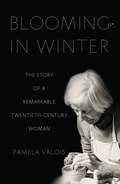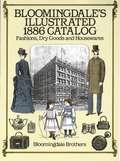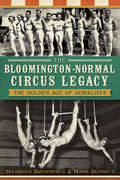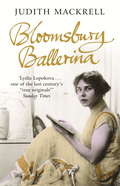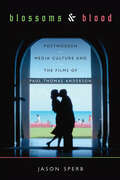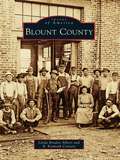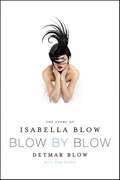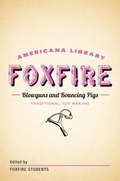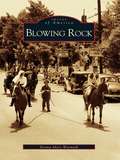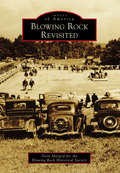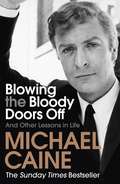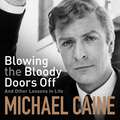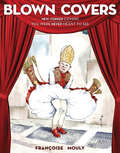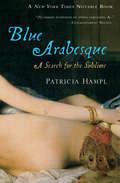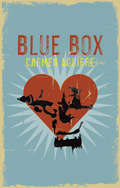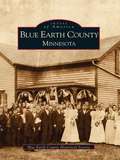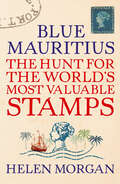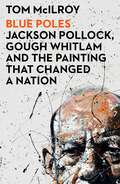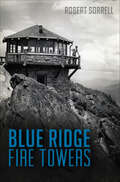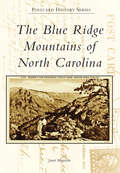- Table View
- List View
Blooming in Winter: The Story of a Remarkable Twentieth-Century Woman
by Pamela ValoisWhen Pam Valois, a young photographer, met Jacomena Maybeck in 1979, she saw the woman she wanted to be in her own later years. Tarring roofs and splitting logs into her eighties, Jackie presided over the legacy of Bernard Maybeck and his clan on Berkeley’s legendary Nut Hill. The friendship between the two women led to a best-selling book—Gifts of Age, a treasury of stories about successful aging. Blooming in Winter is an intimate portrait of Jackie that gives us a paradigm for living exuberantly until the very end.
Bloomingdale's Illustrated 1886 Catalog: Fashions, Dry Goods And Housewares
by Bloomingdale BrothersIn the spring and summer of 1886, a popular New York department store advertised its wares in a finely illustrated catalog featuring everything from clothing, accessories, and housewares, to jewelry, leather goods, school supplies, and dry goods. This excellent reproduction of that now-rare Bloomingdale Brothers catalog provides fascinating views of approximately 1,700 mid-Victorian consumer items (all finely drawn and easy to reproduce) together with the original descriptive captions.An informative introduction by Nancy Villa Bryk, Curator of Domestic Life at the Henry Ford Museum and Greenfield Village, precedes an entertaining panorama of fashions and other articles that include a stylish boucle jacket trimmed in velvet, a woman's tight-waisted riding costume, a variety of little girls' checkered pinafores (averaging about 35 cents apiece), infants' bibs, nurses' caps and aprons, men's nightshirts, suspenders, and smoking jackets; hosiery, hair goods, notions, parasols, silverware, toys, upholstery goods, fine millinery, delicate white laces, exquisite gold jewelry (remarkably inexpensive by today's standards), as well as "willow ware, walking sticks, zephyr worsteds, and fancy articles."Artists and designers will find this catalog a splendid sourcebook of copyright-free period graphics; antique collectors, historians, costume enthusiasts, and nostalgia lovers will find it indispensable for dating and identifying antiques, clothing, and other vintage items.
Bloomington-Normal Circus Legacy, The: The Golden Age of Aerialists
by Maureen Brunsdale Mark SchmittStarting in the 1870s, the barns, icehouses, gymnasiums and empty theaters of central Illinois provided the practice sites for aerial performers whose names still command reverence in the annals of American circus history. Meet Fred Miltimore and the Green Brothers, runaways from the Fourth Ward School who became the first Bloomington-born flyers. Watch Art Concello, a ten-year-old truant, become first a world-class flyer, then a famous trapeze impresario and finally Ringling Brothers and Barnum and Bailey Circus's most successful general manager. The entire art of the trapeze--instruction, training, performance and management--became a Bloomington-Normal industry during the tented shows' golden age, when finding a circus flying act without a connection to this area would have been virtually impossible.
Bloomsbury Ballerina: Lydia Lopokova, Imperial Dancer and Mrs John Maynard Keynes
by Judith MackrellThe story of the splendidly unpredictable Russian dancer who ruffled the feathers of the Bloomsbury set and became the wife of John Maynard KeynesBorn in 1891 in St Petersburg, Lydia Lopokova lived a long and remarkable life. Her vivacious personality and the sheer force of her charm propelled her to the top of Diaghilev's Ballet Russes. Through a combination of luck, determination and talent, Lydia became a star in Paris, a vaudeville favourite in America, the toast of Britain and then married the world-renowned economist, and formerly homosexual, John Maynard Keynes.Lydia's story links ballet and the Bloomsbury group, war, revolution and the economic policies of the super-powers. She was an immensely captivating, eccentric and irreverent personality: a bolter, a true bohemian and, eventually, an utterly devoted wife.
Bloomsbury Ballerina: Lydia Lopokova, Imperial Dancer and Mrs John Maynard Keynes
by Judith MackrellThe story of the splendidly unpredictable Russian dancer who ruffled the feathers of the Bloomsbury set and became the wife of John Maynard KeynesBorn in 1891 in St Petersburg, Lydia Lopokova lived a long and remarkable life. Her vivacious personality and the sheer force of her charm propelled her to the top of Diaghilev's Ballet Russes. Through a combination of luck, determination and talent, Lydia became a star in Paris, a vaudeville favourite in America, the toast of Britain and then married the world-renowned economist, and formerly homosexual, John Maynard Keynes.Lydia's story links ballet and the Bloomsbury group, war, revolution and the economic policies of the super-powers. She was an immensely captivating, eccentric and irreverent personality: a bolter, a true bohemian and, eventually, an utterly devoted wife.
Bloomsbury: A House of Lions
by Leon Edel"A House of Lions" is a series of biographical essays on the principal figures in the "Bloomsbury Group" -- writers, painters, critics, economic and political activists who came together during the Edwardian period and flourished beyond the Second World War.
Blossoms & Blood: Postmodern Media Culture and the Films of Paul Thomas Anderson
by Jason SperbThis analysis of the films of P. T. Anderson is &“a case study of how even the most self-determined directors are always borne aloft by cultural events&” (Cineaste). From his film festival debut Hard Eight to ambitious studio epics Boogie Nights, Magnolia, and There Will Be Blood, Paul Thomas Anderson&’s unique cinematic vision focuses on postmodern excess and media culture. In Blossoms and Blood, Jason Sperb studies the filmmaker&’s evolving aesthetic and its historical context to argue that Anderson&’s films create new, often ambivalent, narratives of American identity in a media-saturated world.Blossoms and Blood explores Anderson&’s films in relation to the aesthetic and economic shifts within the film industry and to America&’s changing social and political sensibilities since the mid-1990s. Sperb provides an auteur study with important implications for film history, media studies, cultural studies, and gender studies. He charts major themes in Anderson&’s work, such as stardom, self-reflexivity, and masculinity and shows how they are indicative of trends in late twentieth-century American culture. One of the first books to focus on Anderson&’s work, Blossoms and Blood reveals the development of an under-studied filmmaker attuned to the contradictions of a postmodern media culture. &“Jason Sperb is not a fan of Paul Thomas Anderson. He&’s something much better—an intelligent critic trying to discern what&’s valuable and what&’s not in Anderson&’s body of cinematic work.&” ―Milwaukee Express &“Sperb has complete mastery of the critical and industrial histories of the films.&” —Choice
Blount County (Images of America)
by B. Kenneth Cornett Linda Braden AlbertBlount County is the 10th county formed in the state of Tennessee. It was carved out of Knox County in 1795 and named for William Blount, the governor of the Territory South of the River Ohio. Maryville is the county seat and was named for Blount's wife, Mary Grainger Blount. The abundance of natural resources that once drew hardy settlers now attracts tourists from all over the world, especially to Cades Cove, a pioneer settlement in the Blount County section of Great Smoky Mountains National Park. Blount County has been home to the legendary Sam Houston; U.S. Senator Lamar Alexander, who also served as Tennessee's governor; and Bessie Harvey, a world-renowned folk artist.
Blow by Blow: The Story of Isabella Blow
by Detmar Blow Tom Sykes“One of the most original and influential people of the twentieth century to me and many others.” —Alexander McQueenWith a career spanning thirty years in fashion, as an influential voice at Vogue, Tatler, and The Sunday Times Magazine—as well as a legacy as one of the industry’s kingmakers for discovering Philip Treacy, Alexander McQueen, Sophie Dahl, and Hussein Chalayan—Isabella Blow had been a pillar of couture culture until her suicide in 2007 left the fashion world mourning one of its finest friends and patrons. Blow by Blow is a captivating journey through Issie’s life, a one-of-a-kind look at her unforgettable impact on the fashion world, and a moving exploration of her inspiring and ultimately tragic tale.
Blowguns and Bouncing Pigs: The Foxfire Americana Library (6) (The Foxfire Americana Library)
by Inc. Foxfire FundThe Foxfire Americana Library takes you back to the good ol' days with a collection of simple, classic toys that can be made at home. Complete with illustrated step-by-step instructions, "Blowguns and Bouncing Pigs" includes advice on how to make: Ball and CupsBlowgunsBouncing PigsBows and ArrowsBubble BlowersBull GrindersButtons on a StringClimbing BearsCorn GunsCornstalk AnimalsCornstalk FiddleApple-head DollsCucumber DollsFluttermillsFly GunsHoopsJumping JacksKicking MulesLimberjacksPop GunsPuzzlesRattletrapsRolling ClownsSling ShotsSmoke GrindersSquirt GunsStick HorsesStiltsGrapevine SwingsRope SwingsTops or DancersWhimmy Diddles or Jeep SticksHollow WhistlesSplit WhistlesWhittled Animals
Blowing Rock
by Donna Akers WarmuthThe beautiful and mountainous area of Blowing Rock, North Carolina, has a rich history dating back to the days when the Native Americans passed through on the Nickajack Trail, which led into Tennessee. The town derives its unique name from a rock outcropping near the town, where the winds defy gravity and have the ability to blow light objects thrown from the rock back to the rock. During the 1790s, several families settled the area, and by the mid-1850s, inhabitants of Blowing Rock along with summer visitors from Lenoir enjoyed the beauty and comfort of the mountainous area. The construction of the Lenoir-Blowing Rock Turnpike after 1845 provided easier access to "America's Switzerland," and visitors or "cottagers," as they were called, soon began building second homes in the area. The images contained within Blowing Rock provide readers with a glimpse into the small-town charm, friendly faces, and inspiring scenery that ensure the town's future as a destination for those who yearn for the comfort of mountain life.
Blowing Rock Revisited
by Trent Margrif Blowing Rock Historical SocietyVoted "the Prettiest Small Town in North Carolina" and often referred to as the Crown of the Blue Ridge, Blowing Rock is the highlight of the High Country. Named for a unique, natural feature itself, Blowing Rock has always represented a distinctive blend of natural and cultural heritage. The town was first developed as an early resort area, which grew quickly in the 1890s. Modern boardinghouses, hotels, and inns were the first significant businesses in Blowing Rock and helped the town survive--even flourish--during the Great Depression. Added attractions in the 1950s and 1960s made Blowing Rock a year-round vacation paradise for families, which it still is today. Yet the heart of Blowing Rock lies within its community and residents who make their small town a wonderful place to visit and an even better place to live.
Blowing the Bloody Doors Off: And Other Lessons in Life
by Michael CaineWith over 100 movies and two Academy Awards to his credit over six decades, Hollywood legend Michael Caine shares the wisdom, stories, insight, and skills that life has taught him in his remarkable career--and now his 85th year. One of our best-loved actors Michael Caine has starred in a huge range of films from the classic movies Alfie, Zulu, and The Italian Job (the inspiration for the book title) to the Hollywood blockbusting Dark Knight trilogy, Dirty Rotten Scoundrels, Hannah and Her Sisters, and Cider House Rules. Caine has excelled in every kind of role--with a skill that's made it look easy. He knows what success takes--he's made it to the pinnacle of his profession from humble origins. But as he says, "Small parts can lead to big things. And if you keep doing things right, the stars will align when you least expect it." Now in his 85th year--and more beloved than ever--he wants to share everything he's learned. With brilliant new insight into his life and work and showcasing his wonderful gift for storytelling, Blowing the Bloody Doors Off is Caine at his wise and entertaining best.
Blowing the Bloody Doors Off: And Other Lessons in Life
by Michael Caine'Wise, funny' Daily Mail'Chatty and engaging . . . he often comes across as endearingly humble' Sunday Times'Thoroughly engaging' Sunday Express magazine'Fabulous storytelling' PrimaOne of 'the top 25 most compelling Hollywood autobiographies' -GuardianHollywood legend and British national treasure Sir Michael Caine shares the wisdom, stories, insight and skills that life has taught him in his remarkable career - and now his 85th year.One of our best-loved actors Michael Caine has starred in a huge range of films - including all-time favourites - from the classic British movies Alfie, Zulu and The Italian Job to the Hollywood blockbusting Dark Knight trilogy, Dirty Rotten Scoundrels, Hannah and Her Sisters and Cider House Rules. Caine has excelled in every kind of role - with a skill that's made it look easy. He knows what success takes - he's made it to the top of his profession from the toughest beginning. But as he says 'Small parts can lead to big things. And if you keep doing things right, the stars will align when you least expect it.' Now in his 85th year he wants to share everything he's learned.With brilliant new insight into his life and work and with his wonderful gift for story, this is Caine at his wise and entertaining best.
Blowing the Bloody Doors Off: And Other Lessons in Life
by Michael CaineWith over 100 movies to his credit over 5 decades, Hollywood legend and British national treasure Michael Caine shares the wisdom, stories, insight and skills for success in life that acting has taught him in his remarkable career.One of our best-loved actors Michael Caine has starred in everything from classic British films Alfie, Zulu and The Italian Job to the Hollywood blockbusting The Dark Knight trilogy and much-loved movie favourites Dirty Rotten Scoundrels, Hannah and Her Sisters and The Quiet American. Caine has excelled in every kind of role - with a skill that's made it look easy. Acting has taught him as much about life as it has his craft. He knows what success takes - not just luck but hard work and preparation. He also knows that it doesn't stop when you're successful. As he says, 'When you reach the top, that's when the climb begins'. Now he wants to share everything he knows.Bringing brilliant new insight into his life and work and with his wonderful gift for story, this is Caine at his wise and entertaining best.(P)2018 Hodder & Stoughton Limited
Blown Covers: New Yorker Covers You Were Never Meant to See
by Françoise MoulyThe art director of The New Yorker serves up“a delicious forbidden taste of the art that didn’t quite nail it, or nailed it a bit too hard” (The Marginalian). Françoise Mouly takes us behind the scenes at The New Yorker and reveals how the magazine creates its signature covers commenting on the most urgent political and cultural events of the day. She shows the shocking and hilarious sketches that didn’t make the cut and explains how these are essential stages in the evolution of a cover that stands the test of time but retains its edge. Her book captures contemporary history—from the farce of Monica Lewinsky to the adventures of Michelle and Barack to nuclear meltdown in Japan—in images that are as acute as they are outrageous. More than that, it shows how the magazine that exemplifies journalistic excellence in America also dares to cultivate a sense of humor when grappling with complex moral and political issues.“Interesting failures are the driving force behind Blown Covers . . . paging through this book is like standing in the corner of her office as she pins up rejected covers on the wall. Mouly has dozens of tales about images that failed for one reason or another. Now, presumably with the approval of her bosses at Condé Nast, she has created a tell-all (or tell-most) that even non–illustrators and designers will find enlightening.” —The New York Times Book Review“Yes, Blown Covers sometimes offends—and that’s the audacious joy of it.” —NPR.org“Offers some true delights.” —The Sacramento Bee“Reveals the shocking and hilarious sketches that didn’t make the cut.” —Patch
Blue
by Museum of Fine Arts, BostonBlue, the world's favorite color, is elegantly showcased in more than 200 artworks from the collection of the Museum of Fine Arts, Boston. Representing a diversity of movements, cultures, and media that spans the ages and the globe, the objects in Blue range from ancient Egyptian jewelry and traditional Japanese prints to Impressionist paintings and indigo-dyed textiles. Short essays from museum curators on the significance and symbolism of the color at various times and places provide historical context for this visual feast. With page edges dyed blue, this distinctive volume is a bijou treasure.
Blue & White Japan
by Yutaka Satoh Amy Slyvester KatohThis delightful book shows that wherever it is used, the creative juxtaposition of blue and white provides both visual nourishment and spiritual balm. From the ephemeral beauty of a wind-blown noren curtain to the powerful geometry of zabuton cushions, to the calming symmetry of a soba cup - whether new or old, homely or sophisticated - all of these objects convey a lyrical message that speaks to our senses, inspiring us to seek out new ways to collect, create, and live with Japanese blue & white
Blue Arabesque: A Search for the Sublime
by Patricia HamplJust out of college, Patricia Hampl was mesmerized by a Matisse painting in the Art Institute of Chicago: an aloof woman gazing at goldfish in a bowl, a Moroccan screen behind her. In Blue Arabesque, Hampl explores the allure of this lounging woman, immersed in leisure, so at odds with the rush of the modern era. Hampl's meditation takes us to the Cote d'Azur and to North Africa, from cloister to harem, pondering figures as diverse as Eugene Delacroix, F. Scott Fitzgerald, and Katherine Mansfield. Returning always to Matisse's portraits of languid women, she discovers they were not decorative indulgences but something much more. Moving with the life force that Matisse sought in his work, Blue Arabesque is Hampl's dazzling and critically acclaimed tour de force.
Blue Box
by Carmen AguirreInterweaving recollections of her revolutionary life in Chile under Augusto Pinochet's regime with her fleeting attempts to realize a "vision" of love in Los Angeles, Carmen Aguirre's one-woman show Blue Box is a fiery proclamation of carnal yearning and social conviction. As ever, Aguirre is assertive, sexy, and wryly political, sharing the sacrifices of her life with humor and courage.Carmen Aguirre is a Vancouver-based theater artist and screen actor who has worked extensively throughout North and South America. She organizes Theatre of the Oppressed workshops and teaches in the acting department at the Vancouver Film School. Her 2011 autobiography, Something Fierce: Memoirs of a Revolutionary Daughter, is an award-winning bestseller.
Blue Earth County, Minnesota
by Blue Earth County Historical SocietyThe first white settlers came to what is now Blue Earth County in 1852, and discovered an abundance of rich land, streams, rivers, and lakes for survival in southern Minnesota. Showcasing photographs from the area's first 70 years, the Blue Earth County Historical Society has compiled over 200 images of the lifestyles and advancements of its earliest settlers.The pioneers of Blue Earth County recognized the potential for success at the bend in the Minnesota River, and forged a vibrant community out of the big woods and prairies of southern Minnesota. Pictured here are the fruits of those settlers' labors, seen in vintage images from the townships of Blue Earth County, including life on the farms and in the towns.
Blue Mauritius: The Hunt for the World's Most Valuable Stamps
by Helen MorganFollow the adventures of the world's most sought-after postage stamps—from a tropical Indian Ocean island to the hushed atmosphere of the modern auction room—in this dramatic and passionate tale of the first stamp hunters. In September 1847 colored squares of paper were stuck on to envelopes and used to send out admission cards to a fancy-dress ball on the tropical island of Mauritius. No one at the party would have guessed that these stamps would one day be worth more than a million dollars. When a two-pence "Blue Mauritius" surfaced on the fledgling French stamp-collecting market in 1865 it gained instant celebrity. Soldiers, schoolboys, and the entire German nation became obsessed with finding one of these extremely rare examples. When in 1903 a perfect specimen, discovered in a childhood album, was bought at auction by the Prince of Wales, the Blue Mauritius gained superstar status. Even now, "Post Office Mauritius" stamps are synonymous with fame, wealth, and mystery. The most coveted scraps of paper in existence, this is their story—from their birth during days of sail, taking them from Port Louis to Bordeaux, India and Great Britain, Switzerland and Japan, into the hearts and imagination of collectors everywhere.
Blue Poles: Jackson Pollock, Gough Whitlam and the Painting That Changed a Nation
by Tom McIlroyThe captivating story behind the iconic Blue Poles - the painter, the process, the patronage, the politics and the national scandal.In 1973, Blue Poles, the iconic painting by America's great abstract expressionist Jackson Pollock, was acquired by the Australian government for A$1.4 million. This record-setting price for an artwork sparked a media sensation and controversy both in Australia and the United States.Blue Poles: Jackson Pollock, Gough Whitlam and the painting that changed a nation details how Jackson Pollock rose to fame, the negotiations that led to the artwork's move to the National Gallery of Australia, and the many successes and turbulent turns in between.This story covers Pollock's entrée into an art circle which included renowned patron Peggy Guggenheim, as well as his relationship with artist Lee Krasner, and the larger-than-life accounts that surrounded his artistic practice - including questions around the creation of Blue Poles.It was Gough Whitlam's commitment to the arts and cultural capital that would see the painting move to another continent, where the media feasted on stories of its cost and brows were raised over its merit. The value of Blue Poles to the Australian art and museum landscape was yet to be foreseen. Journalist Tom McIlroy tells a compelling account of one of Australia's most prized paintings, which stirred up many storms from the time of its creation to its placement in the NGA.
Blue Ridge Fire Towers (Landmarks)
by Robert SorrellFire lookout towers have graced the highest peaks in the Blue Ridge Mountains for more than a century. Early mountaineers and conservationists began constructing lookouts during the late 1800s. By the 1930s, states and the federal government had built thousands of towers around the country, many in the Blue Ridge. While technology allowed forestry services to use other means for early detection of fires, many towers still stand as a testament to their significance. Author Robert Sorrell details the fascinating history of the lookouts in the Blue Ridge's forests.
Blue Ridge Mountains of North Carolina, The (Postcard History Series)
by Janet MorrisonRunning along the western border of the state, the Blue Ridge Mountains of North Carolina have beckoned explorers, settlers, and tourists for generations. Within the ridges and valleys of these mountains, spectacular natural features abound, such as Blowing Rock, Looking Glass Falls, and Linville Gorge. Here, the highest mountain peak in North Carolina, Mount Mitchell, rises to an astonishing 6,684 feet. Recreationally, these mountains boast massive tourist appeal; visitors can hike the Appalachian Trail, drive the Blue Ridge Parkway, or explore the Great Smoky Mountains National Park. This title showcases the natural beauty of the unique mountain range and the numerous mountain communities that many call home.
